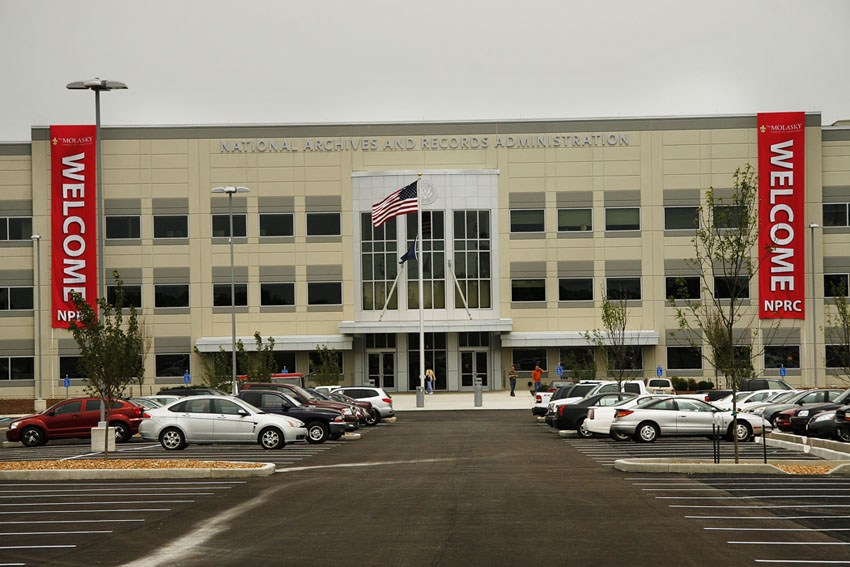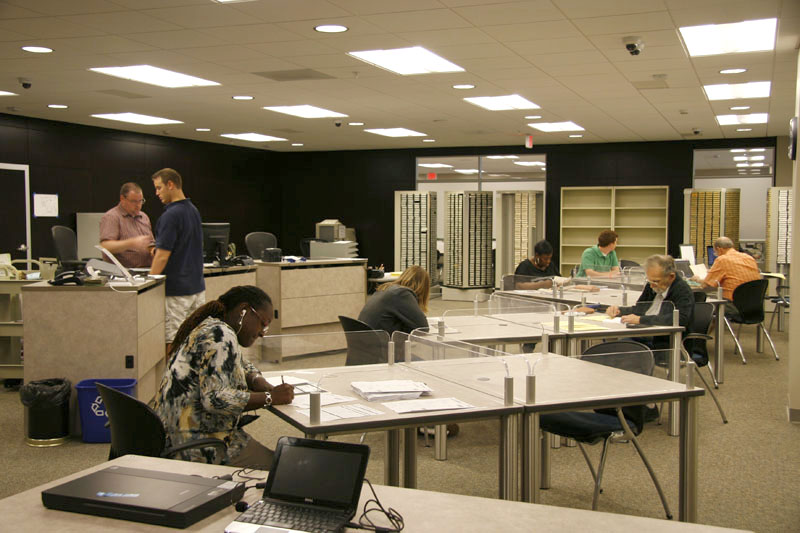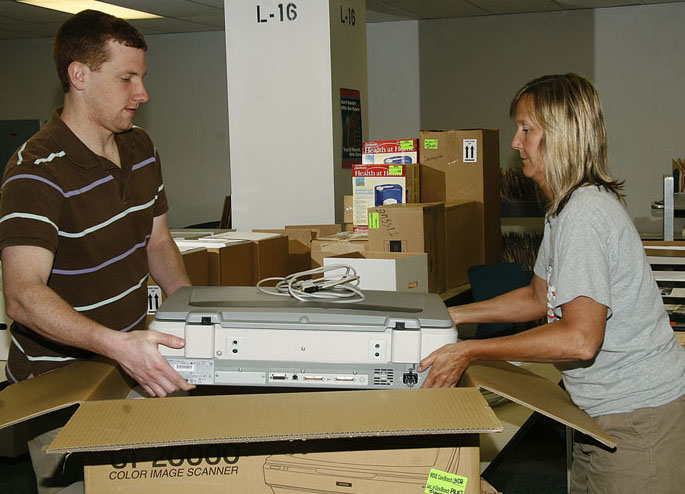
1 Archives Drive
Personnel Records Are Consolidated at New Location in St. Louis
Fall 2011, Vol. 43, No. 3
By William Seibert, Wanda Williams, and Nancy Schuster
The boxes are lined up in neat rows on metal shelves, shelf after shelf after shelf, 15 stacks high. Look up, and you can see through the metal grating to the next floor, and the floors after that, where 14 more stacks rise above you.
The view is impressive, even a bit scary—like standing under the Eiffel Tower and looking straight up.
If you lined up end to end all the boxes that will fill those shelves, they would stretch 545 miles from this new building, housing the National Personnel Records Center (NPRC) and the National Archives at St. Louis, to Dallas.
The statistics behind them are staggering.
These are the personnel files of an estimated 100 million individuals who served their country in the military or as a civilian—about 9 billion textual, digital, and microfilm pages. Some of the files date to 1821, and the largest one is that of Air Force Gen. Henry "Hap" Arnold, at 6,044 pages. The records are in 15 separate storage areas that have a combined capacity of 2.3 million cubic feet.
Moving the files from their old home to this new state-of-the-art archival facility at the rate of 6,000 cubic feet a day will have taken 383 days when it is complete in the fall of 2012. The building itself, which opened earlier this year, sits on more than 7 acres of a 29.5-acre property.
Privately owned and leased by the federal government for the National Archives and Records Administration (NARA), this $115 million building replaces two aging facilities, one of which experienced a fire in 1973 that destroyed millions of records.
The new building is technically the home of two NARA units. One is the NPRC, which has physical but not legal custody of more recent permanent military and civilian records. The other is the National Archives at St. Louis, which has legal custody of older military and civilian permanent files that have been accessioned by the National Archives.
Although it will be a while before all the boxes arrive, the thought of all of them lined up conjures up images from the movie Raiders of the Lost Ark. In fact, the comparison does not end there, because tucked inside each of these boxes are treasures, records just as valuable as the ones Harrison Ford's Indiana Jones found.
These treasures are chapters of people's lives, some covering a few years, some almost a lifetime.
They are stories of heroism, of courage that overrode heartbreak, and of devotion to duty, whether the job was a life-or-death mission or routine office work that too often draws little recognition. There are, of course, stories unflattering to their subjects as well. And they all remain important and relevant long after they happened.
That they are important consider this: The center gets nearly 5,000 requests a day for information from these files—more than 1 million a year—making this arguably our busiest location.
NPRC Boasts a Staff That Can Act Quickly
When Americans need to consult their military or civilian personnel records, our staff—more than 700 in this new building and 185 more in an underground annex in nearby Illinois—are in place to respond quickly.
They came to the rescue of a terminally ill Korean War veteran who was denied access to medical care because he could not find his copy of his discharge document, DD Form 214. Within hours of the request, the staff produced a Certification of Military Service by piecing together a military record for him, using other documents stored at the NPRC, and the veteran got his needed care.
They can quickly pull the file on Sgt. Alvin C. York, who won the Medal of Honor, and retrieve the documentation of his bravery in the face of danger—leading an attack on a German machine-gun nest in World War I, killing dozens of enemy soldiers and capturing more than 100 of them.
They helped a university professor find the missing fact in his search for the complete story of how a group of African American soldiers were court-martialed in Kenya in World War II. That piece of information opened the floodgates for the professor, and he is planning a book.
By consulting a 1920s federal civilian personnel file, they put a Missouri woman back on the right path to finding out why her grandfather disappeared mysteriously.
And they can pull the military file on the late actress Beatrice Arthur and show you her World War II record from the Marines, where the future "Maude" and "Golden Girl" drove trucks and worked as a typist.
This is what happens in this new building in St. Louis County, where the NPRC and the National Archives at St. Louis are co-located. This is where the American people can see and use records about themselves that the government has on file.
Since the early 1950s, the NPRC (including its predecessor organizations) has been the repository for the personnel records of former members of the Army, Navy, Marine Corps, Air Force, and Coast Guard as well as civilian employees of the federal government.
These records are important to veterans and separated civilian employees because they document their time in service and allow them to qualify for the benefits the nation has promised them. The records are equally valuable to their families and future generations.
Archivist of the United States David S. Ferriero underscored the importance of the new facility for both the records and those who request them.
"We are tremendously excited about this new state-of-the-art facility," Ferriero said. "The design and planning were driven by our mission of preserving and protecting the records housed here. Equally as important is our ability to serve the needs of those who need access to the information contained in these records."
He added: "We are very proud of our service to veterans, civil servants, and their families and look forward to providing them with even better service at 1 Archives Drive."
All Personnel Records To Be in Single Facility
For many years, the military and civilian personnel files were stored in separate buildings in the St. Louis area, but it became clear that a new facility was needed when many of the records were reappraised as permanent holdings.
The existing decades-old buildings did not provide appropriate environmental conditions for the storage of permanent records, and a new unit, known as the National Archives at St. Louis, was created to maintain the records as they are transferred into the legal custody of the National Archives.
The temporary records that were stored at the older NPRC buildings have been relocated to the NPRC Annex in Valmeyer, Illinois, about 40 miles southeast of St. Louis. This records center was built in a former underground limestone quarry in the bluffs high above the Mississippi River. An additional 185 employees work in the Annex, which has the capacity for more than 2.5 million cubic feet of records.
In 2009, construction crews broke ground in north St. Louis County for a building to store archived (permanent) and pre-archived records. This massive construction project pumped $435 million into the local economy and generated more than 300 jobs in the St. Louis area.
The new building was built and is owned by the Molasky Group of Companies, which leases it to the General Services Administration and NARA.
The construction has been completed, and most employees are now working in the new building. But the work of relocating more than 2 million cubic feet of permanent records will continue through September 2012. During this time, the NPRC staff will continue to provide timely responses to all reference requests, and efforts are being made to ensure that services to veterans and other customers are carried on with little or no delay for the duration of the move.
When the move is complete, the new facility will have consolidated, for the first time, millions of civilian and military personnel records in a single repository.
The new building is one of the largest in our nationwide network of archives, federal records centers, and Presidential libraries. Its 700 employees are the largest group of National Archives personnel outside the College Park, Maryland, building.
NARA, however, is not the only tenant in this new building. Among the 14 other agencies with offices there are the Department of Veterans Affairs, the Federal Bureau of Investigation, the Federal Aviation Agency, the Secret Service, and units of the individual military services.
New Features: Storage, Research, Public Programs
The new building meets all modern archival standards and is certified under the Leadership in Energy and Environment Design (LEED) program. Archival storage bays are equipped with particulate and ultraviolet filtration. In addition, special paint, sealants, caulking, and the finishes for the shelving have been certified for minimal off-gassing of volatile organic compounds, which are harmful to documents over time.
At the new building, nearly all the records storage units are 29 shelves high, compared to only 10 to 14 shelves high at the older buildings. The staff will gain access to the first 15 shelves by using rolling ladders on the floor level. Two levels of steel catwalk will provide access to the remaining shelves.
The move is also allowing the staff to undertake a rearrangement of its vast holdings to achieve greater efficiency and logical order. Military records will be organized according to the different branches of service, and the civilian personnel records will be shelved by agency.
Visitors will have the advantage of a much larger public research room with more researcher stations that accommodate laptops, scanners, and other equipment.
More than half of all public research room visits are made by persons doing family history research. Authors, academics, and representatives of other federal agencies also use personnel files for a variety of research projects. (See the article on Jack Kerouac's military file elsewhere in this issue as an example.)
Visiting researchers are encouraged to schedule an appointment prior to their arrival.
The new building also has a large multipurpose room equipped with videoconferencing technology. These rooms can be used for training, meetings, public programs, and exhibitions.
NARA's traveling exhibition "Documented Rights" will be on display through the end of February 2012. The public is invited to visit the exhibition, see the new building, and learn about the wealth of National Archives holdings found both locally and around the nation.
Much Data about Individuals Included in Personnel Records
The civilian and military personnel files often contain more than just the standard applications or routine government forms. A family historian may find a photograph, handwritten letters, or other meaningful documents. Even the standard forms can contain information about a veteran's or a former civil servant's parents or guardians, siblings, or spouse as well as other data that can help further a genealogical search.
The Department of Defense and the individual military services retain ownership of the military personnel records when they are initially retired to NPRC.
Only limited information from the files is releasable to the public without the permission of the subject of the record (or if he or she is deceased, the immediate next of kin) as long as the military service department maintains ownership.
Legal title to the military personnel records transfers to the National Archives 62 years after a veteran's discharge, death in service, or retirement. After this transfer of ownership, the records are referred to as "archival" or "accessioned" holdings. Archival records are open to the public; researchers do not need the consent of the veteran (or the next of kin) in order to view or obtain copies of the record.
Currently, the National Archives in St. Louis has 270,245 cubic feet of archival military personnel files (about 56 million individual files), and that volume will increase annually. The oldest holdings are Navy records that document service ending in the 1880s, and the most recent ones are from 2004. (Older military records, including those from the Civil War and others dating back to the Revolutionary War, are housed in the National Archives Building in downtown Washington, DC.)
The archival military personnel files typically contain information about parentage, date and place of birth, physical description, citizenship status, education, prior employment, home address at time of entry into service, marital status, assignment history (units, ships, duty stations), military occupations and ranks, foreign service locations, awards and decorations received, citations for meritorious and valorous conduct, documentation of bad conduct and nonjudicial punishment, and dates and character of service.
The new facility is also the repository for numerous related series of records. They include the Selective Service System Registration Cards and Classification Ledgers that document the military draft in force between 1940 and 1975, Army General Courts Martial Case Files (1911–1976), and Trade Cards describing specific aspects of civilian work in naval shipyards during the late 19th and early 20th centuries.
Civilian personnel records are originally owned by the federal agencies that created them or by one of the agencies with government-wide jurisdiction over personnel matters: the Civil Service Commission or the Office of Personnel Management.
During the past two years, the National Archives has taken legal custody of more than 213,000 cubic feet of civilian personnel records (representing the service of millions of employees), created by more than 112 different federal agencies between 1850 and 1951.
These accessioned civilian personnel files contain valuable information about the personal lives and professional careers of former civil servants employed by the U.S. government in cabinet-level departments and independent agencies. They present a panorama of individual lives ranging from those who rode dusty trails across an American continent as rural postal carriers to men and women who traveled the world as Foreign Service Officers.
Archival civilian personnel folders contain information on parentage, date and place of birth, physical description, citizenship status, education, prior employment and letters of reference, home address, marital status, job series and position descriptions, pay grades, employment locations, letters of commendation, and dates of employment.
Recreating Military Records Destroyed in the 1973 Fire
The NPRC staff will be leaving the site of the 1973 fire: the Page Avenue building where the military records were stored.
Almost 40 years ago, around midnight on July 12, 1973, fire broke out on the sixth floor of the NPRC military records facility. Approximately 22 million personnel files of former members of the Army, Army Air Force, and Air Force who served between 1912 and 1963 were stored there.
For four days, firefighters labored to bring the fire under control and extinguish it. The fire was one of the worst losses of records in U.S. history, destroying 80 percent of the Army records and 75 percent of the Air Force records: an estimated 16 to 18 million individual files. The old building was not equipped with a sprinkler system, and the exact cause of the fire is still undetermined.
In the wake of this disastrous loss of information, employees began to identify and collect record material from other government agencies that could be used to reconstruct aspects of an individual's service history. These holdings are referred to as Auxiliary Records, and the National Archives at St. Louis holds upwards of 50 different series of them.
The most heavily accessed series of Auxiliary Records are various collections of pay records. These payrolls, pay vouchers, and pay rosters provide the most concentrated items of information on a given individual of any of the Auxiliary series. A single pay voucher can document the veteran's rank, unit of assignment, date and place of entry into service, date and place of separation from service, character of service or type of discharge, and prior service, if any.
Many payrolls and rosters show the individual's home address at the time of separation. Pay records that document wartime service also indicate whether, and how long, the veteran served overseas.
The records that were salvaged from the fire sustained damage not only from the blaze but from the water used by the firefighters. These records are maintained in dedicated records storage bays with appropriate temperature and humidity controls.
When the records are required for reference, the St. Louis Preservation staff employs techniques and equipment that safeguard the records and ensure that the information can be extracted from the documents without further damage or loss.
Preservation technicians spend many hours carefully removing mold from and separating documents that were fused together as a result of the fire. Despite the fragile condition of the burned records, staff have been able to retrieve vital data to verify service and ensure that veterans receive the benefits to which they are entitled.
Newly Opened Records Series Focus on World Wars I and II
A number of interesting subgroups of personnel records were recently processed and opened to the public for the first time.
One is a collection of personnel files of the female nurses enrolled in the Secretary of War's Army School of Nursing established in 1918. Included are original letters written by female students who reveal their worries about World War I's impact on their lives as well as their pride in being able to "do their bit" in the war.
The school was part of a larger initiative to increase the pool of nurses available for overseas duty during World War I. Walter Reed General Hospital in Washington, DC., managed the program until it was discontinued in 1931.
Other recently opened World War I–related records are the individual personnel files of the Russian Railway Service Corps. This organization was made up of American railroad workers, with no military experience, who were sent to Siberia in 1917 at the request of the Provisional Russian government to improve the operating conditions of the Trans-Siberian Railroad.
Organized at the direction of the President, the corps was under the general supervision of the State Department. The first group of 339 railway engineers, War Department civilian employees, sailed for Vladivostok on November 19, 1917.
The Russian Railway Service Corps operated in Siberia until the spring of 1920, shortly after the overthrow of the White Russian government in Irkutsk, when members of the corps were evacuated from the country along with U.S. Army troops.
Of particular interest to genealogists is a group of records found among the Panama Canal Company's earliest personnel files. These records provide a fascinating glimpse into the lives of the men hired to build the canal in the first years of the last century. Included are the files of U.S. citizens as well as of Caribbean contract workers. Today, descendants of the contract employees can use these records to trace their West Indian and Latin American ancestry.
One of the most remarkable groups of government employees to emerge during the World War II was the Women's Army Service Pilots, or WASPs. Accomplished aviators as well as newly trained enthusiasts, these women, more than 1,000 strong, had the responsibility of delivering planes from the assembly lines of aircraft factories around the country to military bases worldwide.
Their individual personnel folders contain a wealth of compelling documentation, including photographs, applications for employment that provide detailed vital statistics and biographical data, Aviation Cadet Qualifying Examinations, clothing and equipment issuance lists, letters of recommendation, and results of physical examinations for flying.
There is also correspondence with Jacqueline Cochran, who in early 1942 was authorized by the Chief of Staff for Air, Gen. Henry "Hap" Arnold, to organize and head the program. Other letters provide insight into the experiences of these intrepid women fliers.
The personnel records at NPRC and the National Archives at St. Louis tell the stories of Americans who served their country in uniform, fighting wars and keeping the peace, and as civilians, making federal programs work for Americans.
At the new facility at 1 Archives Drive, these stories of the men and women who served their country are safeguarded just as securely as records in other NARA facilities around the country—records that document and guarantee citizen rights, hold government officials accountable and record the national experience.
Whether finding or reconstructing documentation of an individual's service or assisting visitors in their research of a chapter in someone's life, no job is too small for the St. Louis staff of the National Archives and Records Administration.
William Seibert serves as chief of archival operations in St. Louis. He joined the staff of the National Archives in 1978, working first in the NPRC's Records Reconstruction Branch. Subsequently, he served as assistant chief in the Air Force Reference Branch, senior appraisal archivist and chief of the center's Appraisal and Disposition Section, and NPRC preservation officer.
Wanda Williams has been an archivist with the National Archives at St. Louis since 2009. Her career with NARA began in 2006 as a reference archives technician and with the Nixon Library's Watergate tapes team. She holds an M.A. in U.S. and Caribbean history from Morgan State University in Baltimore, Maryland, and is an active member of the Society for Historians of American Foreign Relations and the Association for the Study of African American Life and History.
Nancy Schuster is a management and program analyst with the National Archives in St. Louis. Of her 34 years of federal service, she has been with NARA for 16 years.





